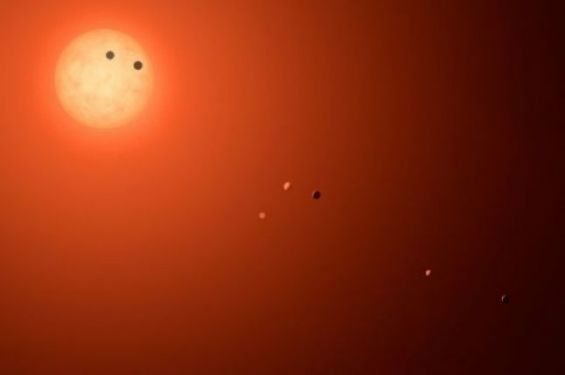Last week, a new study on the 7 planets of the TRAPPIST-1 , discovered in 2017, was published by the Planetary Science Journal. Conducted by the Oukaimeden Observatory (Cadi Ayyad University), the High Energy Physics and Astrophysics Laboratory (LPHEA) and NASA researchers, the study brings new evidence on the density and the probable composition of these seven planets, about 40 light-years from the Sun in the Aquarius constellation.
«This is an important study and a major turning point, because it is the first of its kind», Professor Zouhair Benkhaldoun, director of the Oukaimeden Observatory, told Yabiladi on Wednesday. Along with Pr. Khalid Barkaoui, he is one of the authors of a new study entitled «Refining the Transit-timing and Photometric Analysis of TRAPPIST-1: Masses, Radii, Densities, Dynamics, and Ephemerides».
Same size as Earth but different composition
«In the first study, we announced that all of these planets are practically the same size as Earth, are terrestrial and three of them are located in the habitable zone, where we can have liquid water and a suitable temperature for life», he recalled. «Now we calculated their density, comparing with what is happening in the solar system and their probable composition, thanks to the peculiarity of this system and the fact that these planets are in mutual resonance with each other», he explains.
Indeed, according to a press release by the Oukaimeden Observatory, the new study shows that the planets have remarkably similar densities. «This means that the planets all contain roughly the same ratio of materials believed to make up most of the rocky planets, such as iron, oxygen, magnesium and silicon», the same statement read.
In this case, the composition of the TRAPPIST-1 planets is different from that of Earth: they are about 8% less dense than they would be if they had the same composition as our own planet. The researchers hypothesized that the mixture of bulk ingredients could give the TRAPPIST-1 planets this specific density.
«The pattern of masses and radii may be consistent with a uniform planetary composition for all seven planets that have lower uncompressed densities than Earth, Mars, or Venus, with weaker evidence for a declining normalized density with orbital period», the study revealed.
Assumptions about the presence of water
Alternatively, the study, which also suggests that the iron in the TRAPPIST-1 planets could be infused with high levels of oxygen, forming iron oxide or rust, looked at another element : the presence of water. «The planets may have an Earth-like composition but enhanced in light elements, such as a surface water layer or a core-free structure with oxidized iron in the mantle. We measure planet masses to a precision of 3%–5%, equivalent to a radial-velocity (RV) precision of 2.5 cm s−1, or two orders of magnitude more precise than current RV capabilities», researchers wrote.
The TRAPPIST-1 star is home to the largest batch of roughly Earth-size planets ever found. Now we know even more about the densities of these seven rocky worlds.
— NASA Exoplanets (@NASAExoplanets) January 22, 2021
And the composition of the TRAPPIST-1 planets could be notably different than Earth's! https://t.co/h8cw3VY2PS pic.twitter.com/K4TOgYgYE2
As for the three internal planets of TRAPPIST-1, the study estimates, that they are positioned «too close» to their star for the water to remain in a liquid form in most circumstances, which would require hot and dense atmospheres as on Venus where water could remain tied to the planet in the form of vapor.
In addition to observations made at the Oukaimeden Observatory and other terrestrial telescopes, the new study used data provided by the Kepler Space Telescope and the Spitzer Space Telescope. Managed by NASA's Jet Propulsion Laboratory in Southern California, the latter provided more than 1,000 hours of targeted observations of the system before being decommissioned in January 2020.
Professor Zouhair Benkhaldoun, for his part, confirms that the Oukaimeden Observatory will continue to scan the sky in the direction of TRAPPIST-1 and continue research in connection with these seven planets resembling ours.




 chargement...
chargement...












